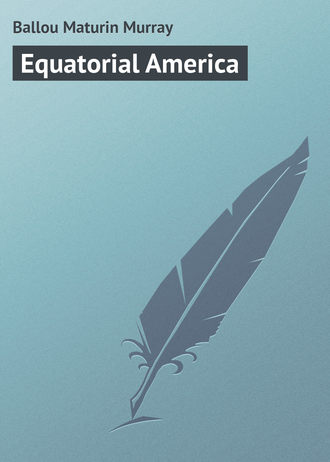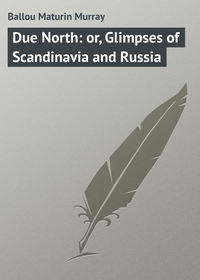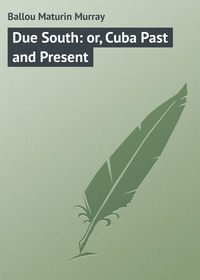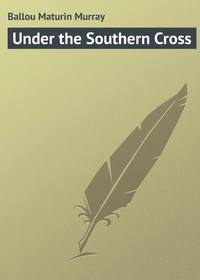 полная версия
полная версияEquatorial America
The myth of a lost continent is doubtless familiar to the reader, – a continent supposed to have existed in these waters thousands of years ago, but which, by some evolution of nature, became submerged, sinking from sight forever. It was the Atlantis which is mentioned by Plato; the land in which the Elysian Fields were placed, and the Garden of Hesperides, from which the early civilization of Greece, Egypt, and Asia Minor were derived, and whose kings and heroes were the Olympian deities of a later time. The poetical idea prevails that this plant, which once grew in those gardens, having lost its original home, has become a floating waif on the sapphire sea of the tropics. The color of the Sargasso weed is a faint orange shade; the leaves are pointed, delicate, and exquisitely formed, like those of the weeping willow in their youthful freshness, having a tiny, round, light green berry near the base of each leaf. Mother Cary's chickens are said to be fond of these berries, and that bird abounds in these waters.
Probably the main portion of the West Indian islands was once a part of the continent of America, many, many ages ago. There are trees of the locust family growing among the group to-day, similar to those found on our southern coast, which are declared to be four thousand years old. This statement is partially corroborated by known characteristics of the growth of the locust, and there are arborists who fully credit this great longevity. It is interesting to look upon an object which had a vital existence two thousand years and more before Christ was upon earth, and which is still animate.
* * * * *Each new island which one visits in the West Indies seems more lovely than its predecessor, always leaving Hayti out of the question; but Martinique, at this moment of writing, appears to rival all those with which the author is familiar. It might be a choice bit out of Cuba, Singapore, or far-away Hawaii. Its liability to destructive hurricanes is its only visible drawback. Having been discovered on St. Martin's day, Columbus gave it the name it now bears.
St. Pierre is the commercial capital of Martinique, one of the French West Indies, and the largest of the group belonging to that nation. Fort de France is the political capital, situated about thirty miles from St. Pierre. It was nearly ruined by the cyclone of last August, a few weeks after the author's visit. St. Pierre is the best built town in the Lesser Antilles, and has a population of about twenty-five thousand. The streets are well paved, and the principal avenues are beautified by ornamental trees uniformly planted. The grateful shade thus obtained, and the long lines of charming arboreal perspective which are formed, are desirable accessories to any locality, but doubly so in tropical regions. The houses are very attractive, while there is a prevailing aspect of order, cleanliness, and thrift everywhere apparent. It was not our experience to meet one beggar in the streets of St. Pierre. More or less of poverty must exist everywhere, but it does not stalk abroad here, as it does in many rich and pretentious capitals of the great world. The island is situated midway between Dominica and St. Lucia, and is admitted by all visitors to be one of the most picturesque of the West Indian groups. Irregular in shape, it is also high and rocky, thus forming one of the most prominent of the large volcanic family which sprang up so many ages ago in these seas. Its apex, Mont Pelée, an only partially extinct volcano, rises between four and five thousand feet above the level of the ocean, and is the first point visible on approaching the island from the north. It would be interesting to dilate upon the past history of Martinique, for it has known not a little of the checkered vicissitudes of these Antilles, having been twice captured by the English, and twice restored to France. But this would not be in accordance with the design of these pages.
St. Pierre is situated on the lee side of the island, something less than two thousand miles, by the course we have steered, from New York, and three hundred miles from St. Thomas. It comes down to the very water's edge, with its parti-colored houses and red-tiled roofs, which mingle here and there with tall, overhanging cocoa-palms. This is the most lavishly beautiful tree in the world, and one which never fails to impart special interest to its surroundings.
A marble statue in the Place de la Savane, at Fort de France, on the same side of the island as St. Pierre, recalls the fact that this was the birthplace of the Empress Josephine, born in 1763. Her memorable history is too familiar for us to repeat any portion of it here, but the brain becomes very active at the mere mention of her name, in recalling the romantic and tragic episodes of her life, so closely interwoven with the career of the first Napoleon. One instinctively recalls the small boudoir in the palace of Trianon, where her husband signed the divorce from Josephine. That he loved her with his whole power for loving is plain enough, as is also his well known reason for the separation, namely, the desire for offspring to transmit his name to posterity. There is one legend which is always rehearsed to strangers, relating to Josephine's youth upon the island. We refer to that of the old negress fortune-teller who prognosticated the grandeur of her future career, together with its melancholy termination, a story so tinctured with local color that, if it be not absolutely true, it surely ought to be. The statue, unless we are misinformed, was the gift of that colossal fraud, Napoleon III., though it purports to have been raised to the memory of Josephine by the people of Martinique, who certainly feel great pride in the fact of her having been born here, and who truly venerate her memory. The statue represents the empress dressed in the fashion of the First Empire, with bare arms and shoulders, one hand resting on a medallion bearing a profile of the emperor to whom she was devoted. The whole is partially shaded by a half dozen grand old palms. The group teems with historic suggestiveness, recalling one of the most tragic chapters of modern European history. It seemed to us that the artist had succeeded in imparting to the figure an expression indicating something of the sad story of the original.
This beautiful island, it will be remembered, also gave to France another remarkable historic character, Françoise d'Aubigné, afterwards Madame Scarron, but better known to the world at large as Madame de Maintenon. She, too, was the wife of a king, though the marriage was a left-handed one, but as the power behind the throne, she is well known to have shaped for years the political destinies of France.
St. Pierre has several schools, a very good hotel, a theatre, a public library, together with some other modern and progressive institutions; yet somehow everything looked quaint and olden, a sixteenth century atmosphere seeming to pervade the town. The windows of the ordinary dwellings have no glass, which is very naturally considered to be a superfluity in this climate; but these windows have iron bars and wooden shutters behind them, relics of the days of slavery, when every white man's house was his castle, and great precautions were taken to guard against the possible uprising of the blacks, who outnumbered their masters twenty to one.
Though so large a portion of the population are of negro descent, yet they are very French-like in character. The native women especially seem to be frivolous and coquettish, not to say rather lax in morals. They appear to be very fond of dress. The young negresses have learned from their white mistresses how to put on their diaphanous clothing in a jaunty and telling fashion, leaving one bronzed arm and shoulder bare, which strikes the eye in strong contrast with the snow white of their cotton chemises. They are Parisian grisettes in ebony, and with their large, roguish eyes, well-rounded figures, straight pose, and dainty ways, the half-breeds are certainly very attractive, and only too ready for a lark with a stranger. They strongly remind one of the pretty quadroons of Louisiana, in their manners, complexion, and general appearance; and like those handsome offspring of mingled blood, so often seen in our Southern States, we suspect that these of Martinique enjoy but a brief space of existence. The average life of a quadroon is less than thirty years.
Martinique is eight times as large as St. Thomas, containing a population of about one hundred and seventy-five thousand. Within its borders there are at least five extinct volcanoes, one of which has an enormous crater, exceeded by only three or four others in the known world. The island rises from the sea in three groups of rugged peaks, and contains some very fertile valleys. So late as 1851, Mont Pelée burst forth furiously with flames and smoke, which naturally threw the people into a serious panic, many persons taking refuge temporarily on board the shipping in the harbor. The eruption on this occasion did not amount to anything very serious, only covering some hundreds of acres with sulphurous débris, yet serving to show that the volcano was not dead, but sleeping. Once or twice since that date ominous mutterings have been heard from Mont Pelée, which it is confidently predicted will one day deluge St. Pierre with ashes and lava, repeating the story of Pompeii.
Sugar, rum, coffee, and cotton are the staple products here, supplemented by tobacco, manioc flour, bread-fruit, and bananas. Rum is very extensively manufactured, and has a good mercantile reputation for its excellence, commanding as high prices as the more famous article of the same nature produced at Jamaica. The purpose of the author is mainly to record personal impressions, but a certain sprinkling of statistics and detail is inevitable, if we would inform, as well as amuse, the average reader.
The flora of Martinique is the marvel and delight of all who have enjoyed its extraordinary beauty, while the great abundance and variety of its fruits are believed to be unsurpassed even in the prolific tropics. Of that favorite, the mango, the island produces some forty varieties, and probably in no other region has the muscatel grape reached to such perfection in size and flavor. The whole island looks like a maze of greenery, as it is approached from the sea, vividly recalling Tutuila of the Samoan group in the South Pacific. Like most of the West Indian islands, Martinique was once densely covered with trees, and a remnant of these ancient woods creeps down to the neighborhood of St. Pierre to-day.
The principal landing is crowded at all times with hogsheads of sugar and molasses, and other casks containing the highly scented island rum, the two sweets, together with the spirits, causing a nauseous odor under the powerful heat of a vertical sun. We must not forget to mention, however, that St. Pierre has a specific for bad odors in her somewhat peculiar specialty, namely, eau-de-cologne, which is manufactured on this island, and is equal to the European article of the same name, distilled at the famous city on the Rhine. No one visits the port, if it be for but a single day, without bringing away a sample bottle of this delicate perfumery, a small portion of which, added to the morning bath, is delightfully refreshing, especially when one uses salt water at sea, it so effectively removes the saline stickiness which is apt to remain upon the limbs and body after a cold bath.
The town is blessed with an inexhaustible supply of good, fresh, mountain water, which, besides furnishing the necessary quantity for several large drinking fountains, feeds some ornamental ones, and purifies the streets by a flow through the gutters, after the fashion of Salt Lake City, Utah. This is in fact the only system of drainage at St. Pierre. A bronze fountain in the Place Bertin is fed from this source, and is an object of great pleasure in a climate where cold water in abundance is an inestimable boon. This elaborate fountain was the gift of a colored man, named Alfred Agnew, who was at one time mayor of the city. Many of the gardens attached to the dwelling-houses are ornamented with ever-flowing fountains, which impart a refreshing coolness to the tropical atmosphere.
The Rue Victor Hugo is the main thoroughfare, traversing the whole length of the town parallel with the shore, up hill and down, crossing a small bridge, and finally losing itself in the environs. It is nicely kept, well paved, and, though it is rather narrow, it is the Broadway of St. Pierre. Some of the streets are so abrupt in grade as to recall similar avenues in the English portion of Hong Kong, too steep for the passage of vehicles, or even for donkeys, being ascended by means of much worn stone steps. Fine, broad roadways surround the town and form pleasant drives.
The cathedral has a sweet chime of bells, whose soft, liquid notes came to us across the water of the bay with touching cadence at the Angelus hour. It must be a sadly calloused heart which fails to respond to these twilight sounds in an isle of the Caribbean Sea. Millet's impressive picture was vividly recalled as we sat upon the deck and listened to those bells, whose notes floated softly upon the air as if bidding farewell to the lingering daylight. At the moment, all else being so still, it seemed as though one's heartbeat could be heard, while the senses were bathed in a tranquil gladness incited by the surrounding scenery and the suggestiveness of the hour.
Three fourths of the population are half-breeds, born of whites, blacks, or mulattoes, with a possible strain of Carib blood in their veins, the result of which is sometimes a very handsome type of bronzed hue, but of Circassian features. Some of the young women of the better class are very attractive, with complexions of a gypsy color, like the artists' models who frequent the "Spanish Stairs" leading to the Trinità di Monti, at Rome. These girls possess deep, dark eyes, pearly teeth, with good figures, upright and supple as the palms. In dress they affect all the colors of the rainbow, presenting oftentimes a charming audacity of contrasts, and somehow it seems to be quite the thing for them to do so; it accords perfectly with their complexions, with the climate, with everything tropical. The many-colored Madras kerchief is universally worn by the common class of women, twisted into a jaunty turban, with one well-starched end ingeniously arranged so as to stand upright like a soldier's plume. The love of ornament is displayed by the wearing of hoop earrings of enormous size, together with triple strings of gold beads, and bracelets of the same material. If any one imagines he has seen larger sized hoop earrings this side of Africa, he is mistaken. They are more like bangles than earrings, hanging down so as to rest upon the neck and shoulders. Those who cannot afford the genuine article satisfy their vanity with gaudy imitations. They form a very curious and interesting study, these black, brown, and yellow people, both men and women. In the market-place at the north end of the town, the women preside over their bananas, oranges, and other fruits, in groups, squatting like Asiatics on their heels. In the Havana fish market, one compares the variety of colors exhibited by the fishes exposed for sale to those of the kaleidoscope, but here the Cuban display is equaled if not surpassed.
St. Pierre has a botanical garden, situated about a mile from the centre of the town, so located as to admit of utilizing a portion of the native forest yet left standing, with here and there an impenetrable growth of the feathery bamboo, king of the grasses, interspersed with the royal palm and lighter green tree-ferns. The bamboo is a marvel, single stems of it often attaining a height in tropical regions of a hundred and seventy feet, and a diameter of a foot. So rapid is its growth that it is sometimes known to attain the height of a hundred feet in sixty days. Art has done something to improve the advantages afforded by nature in this botanical garden, arranging some pretty lakes, fountains, and cascades. Vistas have been cut through the dense undergrowth, and driveways have been made, thus improving the rather neglected grounds. One pretty lake of considerable size contains three or four small islands, covered with flowering plants, while on the shore are pretty summer houses and inviting arbors. The frangipanni, tall and almost leafless, but with thick, fleshy shoots and a broad-spread, single leaf, was recognized here among other interesting plants. This is the fragrant flower mentioned by the early discoverers. There was also the parti-colored passion-flower, and groups of odd-shaped cacti, whose thick, green leaves were daintily rimmed with an odorless yellow bloom. Here, also, is an interesting example of the ceba-tree, in whose shade a hundred persons might banquet together. The author has seen specimens of the ceba superbly developed in Cuba and the Bahamas, with its massive and curiously buttressed trunk, having the large roots half above ground. It is a solitary tree, growing to a large size and enjoying great longevity. Mangoes abound here, the finest known as the mango d'or. There is a certain air about the public garden of St. Pierre, indicating that nature is permitted in a large degree to have her own sweet will. Evidences enough remain to show the visitor that these grounds must once have been in a much more presentable condition. There is a musical cascade, which is well worth a long walk to see and enjoy. Just inside of the entrance, one spot was all ablaze with a tiny yellow flower, best known to us as English broom, Cytisus genista. Its profuse but delicate bloom was dazzling beneath the bright sun's rays. Could it possibly be indigenous? No one could tell us. Probably some resident brought it hither from his home across the ocean, and it has kindly adapted itself to the new soil and climate.
We were cautioned to look out for and to avoid a certain poisonous snake, a malignant reptile, with fatal fangs, which is the dread of the inhabitants, some of whom are said to die every year from the venom of the creature. It will be remembered that one of these snakes, known here as the fer-de-lance, bit Josephine, the future empress, when she was very young, and that her faithful negro nurse saved the child's life by instantly drawing the poison from the wound with her own lips. It is singular that this island, and that of St. Lucia, directly south of it, should be cursed by the presence of these poisonous creatures, which do not exist in any other of the West Indian islands, and, indeed, so far as we know, are not to be found anywhere else. The fer-de-lance has one fatal enemy. This is a large snake, harmless so far as poisonous fangs are concerned, called the cribo. This reptile fearlessly attacks the fer-de-lance, and kills and eats him in spite of his venom, a perfectly justifiable if not gratifying instance of cannibalism, where a creature eats and relishes the body of one of its own species. The domestic cat is said also to be more than a match for the dreaded snake, and instinctively adopts a style of attack which, while protecting itself, finally closes the contest by the death of the fer-de-lance, which it seizes just back of the head at the spine, and does not let go until it has severed the head from the body; and even then instinct teaches the cat to avoid the head, for though it be severed from the body, like the mouth of a turtle under similar circumstances, it can still inflict a serious wound.
The fer-de-lance is a great destroyer of rats, this rodent forming its principal source of food. Now as rats are almost as much of a pest upon the island, and especially on the sugar plantations, as rabbits are in New Zealand, it will be seen that even the existence of this poisonous snake is not an unmitigated evil.
Crosses and wayside shrines of a very humble character are to be seen in all directions on the roadsides leading from St. Pierre, recalling similar structures which line the inland roads of Japan, where the local religion finds like public expression, only varying in the character of the emblems. At Martinique it is a Christ or a Madonna; in Japan it is a crude idol of some sort, the more hideous, the more appropriate. The same idea is to be seen carried out in the streets of Canton and Shanghai, only Chinese idols are a degree more unlike anything upon or below the earth than they are elsewhere.
It was observed that while there were plenty of masculine loafers and careless idlers of various colors, whose whole occupation seemed to be sucking at some form of burning tobacco in the shape of cigarette, cigar, or pipe, the women, of whatever complexion, seen in public, were all usefully employed. They are industrious by instinct; one almost never sees them in repose. In the transportation of all articles of domestic use, women bear them upon their heads, whether the article weighs one pound or fifty, balancing their load without making use of the hands except to place the article in position. The women not infrequently have also a baby upon their backs at the same time. Negresses and donkeys perform nine tenths of the transportation of merchandise. Wheeled vehicles are very little used in the West Indian islands. As we have seen, even in coaling ship, it is the women who do the work.
The Hotel des Bains, at St. Pierre, is an excellent hostelry, as such places go in this part of the world. The stranger will find here most of the requisites for domestic comfort, and at reasonable prices. As a health resort the place has its advantages, and a northern invalid, wishing to escape the rigor of a New England winter, would doubtless find much to occupy and recuperate him here. St. Pierre, however, has times of serious epidemic sickness, though this does not often happen in the winter season. Three or four years ago the island was visited by a sweeping epidemic of small-pox, but it raged almost entirely among the lowest classes, principally among the negroes, who seem to have a great prejudice and superstitious fear relating to vaccination, and its employment as a preventive against contracting the disease. In the yellow fever season the city suffers more or less, but the health of St. Pierre will average as good as that of our extreme Southern States; and yet, after all, with the earthquakes, hurricanes, tarantulas, scorpions, and deadly fer-de-lance, as Artemus Ward would say, Martinique presents many characteristics to recommend protracted absence. A brief visit is like a poem to be remembered, but one soon gets a surfeit of the circumscribed island.
Our next objective point was Barbadoes, to reach which we sailed one hundred and fifty miles to the eastward, this most important of the Lesser Antilles being situated further to windward, that is, nearer the continent of Europe. Our ponderous anchor came up at early morning, just as the sun rose out of the long, level reach of waters. It looked like a mammoth ball of fire, which had been immersed during the hours of the night countless fathoms below the sea. Presently everything was aglow with light and warmth, while the atmosphere seemed full of infinitesimal particles of glittering gold. At first one could watch the face of the rising sun, as it came peering above the sea, a sort of fascination impelling the observer to do so, but after a few moments, no human eye could bear its dazzling splendor.
Said an honest old Marshfield farmer, in 1776, who met the clergyman of the village very early in the opening day: "Ah, good mornin', Parson, another fine day," nodding significantly towards the sun just appearing above the cloudless horizon of Massachusetts Bay. "They do say the airth moves, and the sun stands still; but you and I, Parson, we git up airly and we see it rise!"
CHAPTER III
English Island of Barbadoes. – Bridgetown the Capital. – The Manufacture of Rum. – A Geographical Expert. – Very English. – A Pest of Ants. – Exports. – The Ice House. – A Dense Population. – Educational. – Marine Hotel. – Habits of Gambling. – Hurricanes. – Curious Antiquities. – The Barbadoes Leg. – Wakeful Dreams. – Absence of Twilight. – Departure from the Island.
Bridgetown is the capital of Barbadoes, an English island which, unlike St. Thomas, is a highly cultivated sugar plantation from shore to shore. In natural beauty, however, it will not compare with Martinique. It is by no means picturesquely beautiful, like most of the West Indian islands, being quite devoid of their thick tropical verdure. Nature is here absolutely beaten out of the field by excessive cultivation. Thirty thousand acres of sugar-cane are cut annually, yielding, according to late statistics, about seventy thousand hogsheads of sugar. We are sorry to add that there are twenty-three rum distilleries on the island, which do pecuniarily a thriving business. "The poorest molasses makes the best rum," said an experienced manager to us. He might well have added that it is also the poorest use to which it could be put. This spirit, like all produced in the West Indies, is called Jamaica rum, and though a certain amount of it is still shipped to the coast of Africa, the return cargoes no longer consist of kidnapped negroes. The article known as New England rum, still manufactured in the neighborhood of Boston, has always disputed the African market, so to speak, with the product of these islands. Rum is the bane of Africa, just as opium is of China, the former thrust upon the native races by Americans, the latter upon the Chinese by English merchants, backed by the British government. Events follow each other so swiftly in modern times as to become half forgotten by contemporary people, but there are those among us who remember when China as a nation tried to stop the importation of the deadly drug yielded by the poppy fields of India, whereupon England forced the article upon her at the point of the bayonet.









